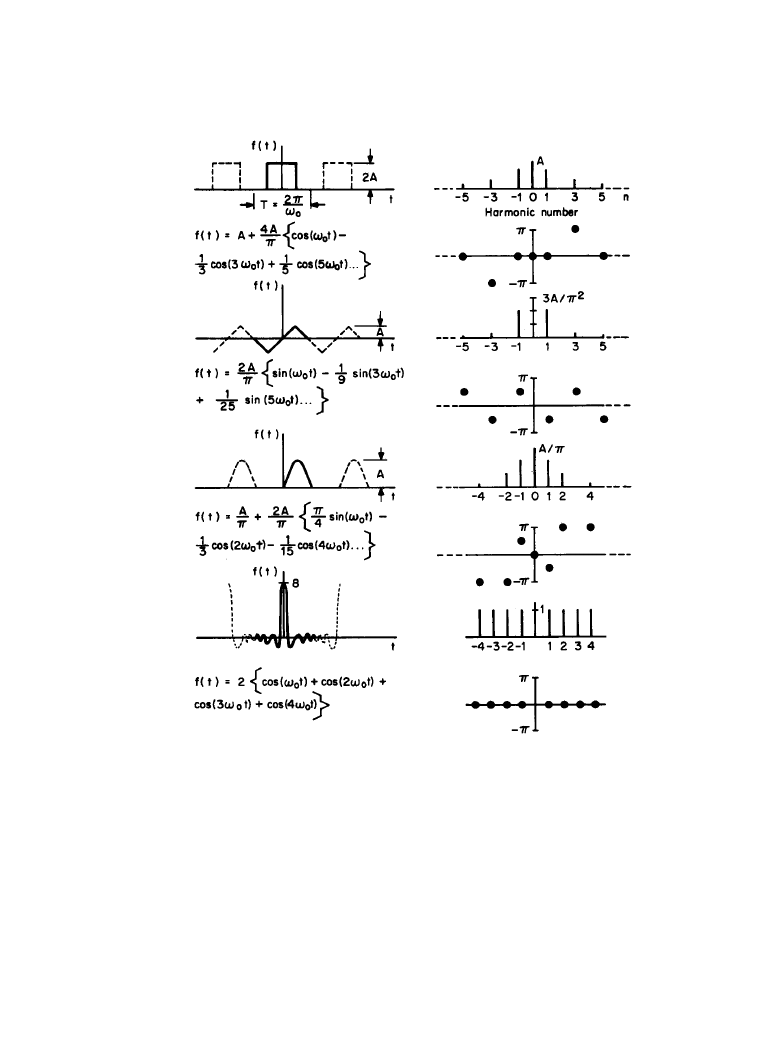ВУЗ: Казахская Национальная Академия Искусств им. Т. Жургенова
Категория: Книга
Дисциплина: Не указана
Добавлен: 03.02.2019
Просмотров: 21592
Скачиваний: 19

2-12 The Audio Spectrum
amplitudes and phases. Within the period T, each higher frequency or higher harmonic will have
an integer number, e.g., 2 or 3 or 4, etc., of full oscillations. The line spectrum is a meaningful
way to represent such a signal in the frequency domain. Before the line spectrum can be drawn,
the amplitudes and phases of the frequency components in the time waveform are required.
These can be found from a specific mathematical analysis of the waveform called Fourier analy-
sis. An understanding of Fourier analysis is essential to the general concept of the spectrum, fre-
quency-domain representation of signals, transformations, and linear signal processing.
2.1.2c
Fourier-Series Analysis
To determine whether a periodic f(t) has a sinusoidal component, cos (
ω
t) for example, at fre-
quency
ω, the product f(t) cos (ωt) is integrated over one full period T = 2π/ω. If, for example, f(t)
= A cos (
ωt), then
(2.1.7)
because cos
2
(
ωt) = 1/2 + 1/2 cos (2ωt) and the second term integrates to zero. Thus, the ampli-
tude A of cos (
ωt) in f(t) is simply 2/T times the integral, Equation (2.1.7). The left integral in
Equation (2.1.7) would equal zero if f(t) = A cos (n
ωt),
, but n = 0, 2, 3.... The same method
applies by using sin (
ωt) if f(t) contains the sinusoidal component A sin (ωt). This forms the basis
for Fourier analysis, that is, a systematic way to determine the harmonic content, in terms of sin
(n
ω
0
t) and cos (n
ω
0
t), for n = 0, 1, 2,..., of a periodic f(t) whose period T = 2
π/ω
0
.
A Fourier series is a mathematical way to represent a real, periodic, finite power signal in
terms of a sum of harmonically related sinusoids. If f(t) is periodic with period T, it repeats itself
every T so that
(2.1.8)
and its Fourier series is given by
(2.1.9)
where
ω
0
= 2
π/T and the Fourier coefficients are real numbers given by
(2.1.10)
and
f t
( )
ωt
( )
cos
dt
T/2
–
T /2
∫
A
ωt
( )
cos
2
t
d
T
2
⁄
T
2
⁄
∫
AT
2
-------
=
=
n
1
≠
f t
T
+
(
)
f t
( )
=
f t
( )
a
0
2
-----
a
n
n
ω
0
t
(
)
cos
n
1
=
∞
∑
b
n
n
1
=
∞
∑
n
ω
0
t
(
)
sin
+
+
=
a
n
2
T
---
f t
( )
n
ω
0
t
(
)
cos
t
d
T /2
–
T/2
∫
=
Downloaded from Digital Engineering Library @ McGraw-Hill (www.digitalengineeringlibrary.com)
Copyright © 2004 The McGraw-Hill Companies. All rights reserved.
Any use is subject to the Terms of Use as given at the website.
Signals and Spectra

Signals and Spectra 2-13
(2.1.11)
The frequency
ω
0
is called the fundamental frequency (or first harmonic) and, for n = 2, 3, 4, .
. ., n
0
are the second, third, fourth, etc., harmonics, respectively. The a
0
/2 term is the average
value or dc (zero-frequency) content of f(t). The Fourier coefficients in Equations (2.1.10) and
(2.1.11) can be interpreted as the average content of cos (n
ω
0
t) and sin (n
ω
0
t), respectively, in f(t).
By using the Euler identity, Equations (2.1.4), (2.1.10), and (2.1.11) can be combined to yield
(2.1.12)
where each c
n
is a complex Fourier coefficient whose magnitude and (phase) angle are, respec-
tively
(2.1.13a)
(2.1.13b)
By defining c
0
= a
0
/2 and, for
(2.1.14)
the Fourier series Equation (2.1.9) can be written as
(2.1.15a)
(2.1.15b)
which can be derived from Equation (2.1.9) by using Equations (2.1.12), (2.1.14), and (2.1.4).
Equation (2.1.15b) is the complex form of the Fourier series and can be interpreted by using
Equation (2.1.15a), which shows the sum of the dc term, positive-frequency terms, and negative-
frequency terms (n has only negative values in the second sum), respectively.
b
n
2
T
---
f t
( )sin nω
0
t
(
) t
d
T /2
–
T/2
∫
=
c
n
a
n
jb
n
–
2
-------------------
1
T
---
f t
( )e
jn
ω
0
t
–
dt
T/2
–
T/2
∫
=
=
φ
c
n
a
n
2
b
n
2
+
(
)/2
=
φ
n
arc
b
n
a
n
-----
–
tan
=
n
0
≠
c
n
–
c
n
*
a
n
jb
n
+
2
-------------------
=
=
f t
( )
c
0
c
n
e
jn
ω
0
t
c
n
e
jn
ω
0
t
n
1
–
=
(
)
∞
–
∫
+
n
1
=
∞
∑
+
=
f t
( )
c
n
e
jn
ω
0
t
n
∞
–
=
∞
∑
=
Downloaded from Digital Engineering Library @ McGraw-Hill (www.digitalengineeringlibrary.com)
Copyright © 2004 The McGraw-Hill Companies. All rights reserved.
Any use is subject to the Terms of Use as given at the website.
Signals and Spectra

2-14 The Audio Spectrum
When a periodic signal is represented in the form (2.1.15b), its corresponding line spectrum
can be viewed, first, as pairs of pure sine waves and cosine waves with different real coefficients
a
n
and b
n
, as prescribed by Equations (2.1.10) and (2.1.11) at positive frequencies n
ω
0
which sum
to form sinusoids like Equation (2.1.6). Using identities (2.1.5), however, these sine waves and
cosine waves also can be written as sums of complex exponentials
and
with
amplitudes and phases given by the complex coefficients c
n
. Alternatively, the line spectrum can
be viewed as sinusoids at positive frequencies n
ω
0
in the form (2.1.6) and each represented as the
sum of a pair of phasors counter-rotating with angular velocities + n
ω
0
and -n
ω
0
whose lengths
equal
, and whose initial phase angle is specified by the angle of c
n
, In both interpretations
negative frequencies are used, but this results in the very compact complex exponential notation
in Equation (2.1.15b), where sine and cosine functions are no longer needed.
Figure 2.1.4 shows different periodic functions of time and their corresponding line spectra
determined from the magnitude and phase (or angle) of the complex Fourier coefficients c
n
.
2.1.2d
Discrete Fourier Series
If a Fourier series has only a finite number of terms (i.e., its frequency band is limited) and the
highest frequency equals K
ω
0
rad/s (the Kth harmonic), then Equation (2.1.15b) simplifies to the
finite sum
(2.1.16)
In certain applications the values of f(t) are needed only at N instants in time (within the period
T) that are spaced T/N apart. The values f(t) at these N points in time, from Equation (2.1.16). are
given by
(2.1.17)
where m is an integer. Choosing the number of points N = 2K, that is, the time interval between
points equal to half of the period of the highest frequency (T/N = T/2K) and substituting 2
π/T for
ω
0
in Equation (2.1.17) gives
(2.1.18)
where
(2.1.19)
e
jn
ω
0
t
e
jn
ω
0
t
–
c
n
f t
( )
c
n
e
jn
ω
0
t
n
K
–
=
K
∑
=
f mT/N
(
)
c
n
e
jn
ω
0
mT/N
n
K
–
=
K
∑
=
f mT/N
(
)
c
n
w
N
nm
n
N /2
–
=
N /2
∑
=
W
N
e
j2
π/N
=
Downloaded from Digital Engineering Library @ McGraw-Hill (www.digitalengineeringlibrary.com)
Copyright © 2004 The McGraw-Hill Companies. All rights reserved.
Any use is subject to the Terms of Use as given at the website.
Signals and Spectra

Signals and Spectra 2-15
which is called the Nth root of unity. The quantity
, for N values of m, mathematically repre-
sents specific points on the unit circle in the complex plane spaced 2
π/N, or 360°/N apart (begin-
ning from e
j0
= 1). Each of these points is physically interpreted as the location of the tip of a
phasor of unit length, which rotates through 2
π rad, or 360°, during the period T at the instants in
time mT/N. Because the phasor for the nth harmonic has an angular velocity n times faster than
that of the fundamental (n = 1), the term
appears in Equation (2.1.18). One way to interpret
the term 2
π/N in Equation (2.1.19) is that, for any one of the N/2 harmonics, only N discrete val-
ues of phase are possible after sampling, regardless of frequency. The coefficients c
n
in Equation
w
n
m
w
N
nm
Figure 2.1.4
Periodic functions and their line spectra.
Downloaded from Digital Engineering Library @ McGraw-Hill (www.digitalengineeringlibrary.com)
Copyright © 2004 The McGraw-Hill Companies. All rights reserved.
Any use is subject to the Terms of Use as given at the website.
Signals and Spectra

2-16 The Audio Spectrum
(2.1.18) are complex numbers of the form
that scale the unit amplitudes and shift the
phases of the sampled harmonics represented by
.
The Fourier coefficients are related to the sampled values of f(t) by the similar equation
(2.1.20)
where the integer M is even and numerically equal to N. Equation (2.1.20) can be substituted into
Equation (2.1.18), or vice versa, to yield an identity. These two equations define an N-point dis-
crete Fourier-series pair which is often called a discrete Fourier transform (DFT) pair. They
relate the N equally spaced sampled values of f(t) in Equation (2.1.18) to its line spectrum, which
contains N/2 negative-frequency components, a dc term, and N/2 positive-frequency components
as well as their phases as prescribed by Equation (2.1.20). For an example, see the last line spec-
trum in Figure 2.1.4
Equation (2.1.20) is a discrete-time version of Equation (2.1.12) and is valid only if the peri-
odic function f(t) is sampled throughout its period T at a rate that is twice the highest frequency it
contains. If f(t) contains harmonics higher than N/2, then the c
n
coefficients in Equation (2.1.20)
are not identical to those in Equation (2.1.12); they will become corrupted or aliased because
higher frequencies (with a harmonic number greater than N/2) in f(t) influence the value of c
n
as
computed from Equation (2.1.20), but these frequencies cannot be reconstructed by using the
harmonics up to harmonic number N/2 as in Equation (2.1.18). Furthermore, the resulting line
spectrum itself will be incorrect.
The DFT can be computed very efficiently from sampled values of f(t), as contained in Equa-
tion (2.1.20), or f(t) can be reconstructed at the sample points, as in Equation (2.1.18), using a
numerical algorithm called the fast Fourier transform (FFT). The algorithm exploits, in compu-
tation, the fact that
represents only N distinct values of phase.
2.1.2e
Spectral Density and Fourier Transformation
Line spectra, where each line | c
n
| represents a sinusoid whose average power is
, can-
not be used to represent the spectrum of a finite-energy signal f(t) because the average power of
f(t), as given in Equation (2.1.2), is zero by definition. Furthermore, while a finite-energy signal
can exist for all time, subject to the constraint given in Equation (2.1.1), it has no finite period T
associated with itself. For finite-energy signals, an amplitude-density spectrum is defined in the
following way
(2.1.21)
The dimensions of F(
ω) are amplitude multiplied by time or amplitude/(l/time) and are inter-
preted as amplitude/frequency. The quantity F(
ω) is called amplitude spectral density or, simply,
spectral density of f(t). By comparing Equation (2.1.21) with Equation (2.1.12), F(
ω) is seen to
be defined for all rather than discrete frequencies, and the limits of integration include all time
rather than one period. Similar to Fourier analysis in concept, the integral (2.1.21) extracts from
c
n
e
j
ψn
w
N
mn
c
n
1
N
----
f mT/N
(
)w
N
n m
–
m
M /
–
2
=
M /2
∑
=
w
N
mn
c
n
2
2
⁄
F
ω
( )
f t
( )e
j
ωt
–
dt
∞
–
∞
∫
=
Downloaded from Digital Engineering Library @ McGraw-Hill (www.digitalengineeringlibrary.com)
Copyright © 2004 The McGraw-Hill Companies. All rights reserved.
Any use is subject to the Terms of Use as given at the website.
Signals and Spectra